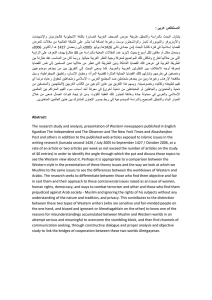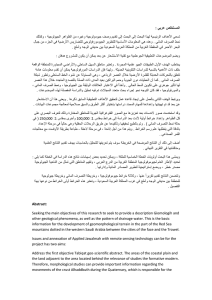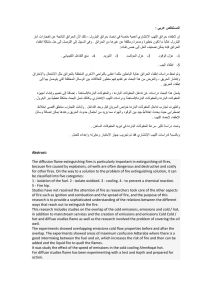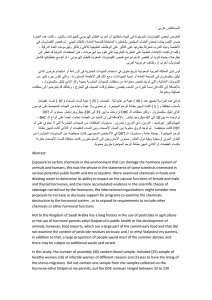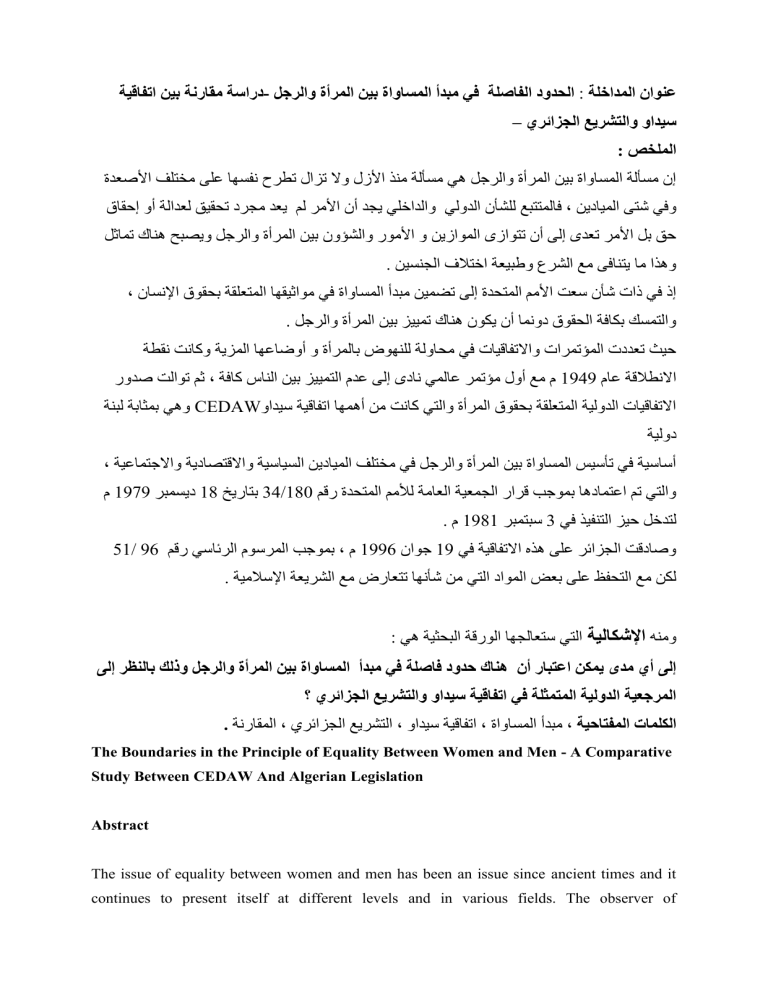
عنوان المداخلة :الحدود الفاصلة في مبدأ المساواة بين المرأة والرجل -دراسة مقارنة بين اتفاقية سيداو والتشريع الجزائري – الملخص : إن مسألة المساواة بين المرأة والرجل هي مسألة منذ األزل وال تزال تطرح نفسها على مختلف األصعدة وفي شتى الميادين ،فالمتتبع للشأن الدولي والداخلي يجد أن األمر لم يعد مجرد تحقيق لعدالة أو إحقاق حق بل األمر تعدى إلى أن تتوازى الموازين و األمور والشؤون بين المرأة والرجل ويصبح هناك تماثل وهذا ما يتنافى مع الشرع وطبيعة اختالف الجنسين . إذ في ذات شأن سعت األمم المتحدة إلى تضمين مبدأ المساواة في مواثيقها المتعلقة بحقوق اإلنسان ، والتمسك بكافة الحقوق دونما أن يكون هناك تمييز بين المرأة والرجل . حيث تعددت المؤتمرات واالتفاقيات في محاولة للنهوض بالمرأة و أوضاعها المزية وكانت نقطة االنطالقة عام 1949م مع أول مؤتمر عالمي نادى إلى عدم التمييز بين الناس كافة ،ثم توالت صدور االتفاقيات الدولية المتعلقة بحقوق المرأة والتي كانت من أهمها اتفاقية سيداو CEDAWوهي بمثابة لبنة دولية أساسية في تأسيس المساواة بين المرأة والرجل في مختلف الميادين السياسية واالقتصادية واالجتماعية ، والتي تم اعتمادها بموجب قرار الجمعية العامة لألمم المتحدة رقم 34/180بتاريخ 18ديسمبر 1979م لتدخل حيز التنفيذ في 3سبتمبر 1981م . وصادقت الجزائر على هذه االتفاقية في 19جوان 1996م ،بموجب المرسوم الرئاسي رقم 51/ 96 لكن مع التحفظ على بعض المواد التي من شأنها تتعارض مع الشريعة اإلسالمية . ومنه اإلشكالية التي ستعالجها الورقة البحثية هي : إلى أي مدى يمكن اعتبار أن هناك حدود فاصلة في مبدأ المساواة بين المرأة والرجل وذلك بالنظر إلى المرجعية الدولية المتمثلة في اتفاقية سيداو والتشريع الجزائري ؟ الكلمات المفتاحية ،مبدأ المساواة ،اتفاقية سيداو ،التشريع الجزائري ،المقارنة . The Boundaries in the Principle of Equality Between Women and Men - A Comparative Study Between CEDAW And Algerian Legislation Abstract The issue of equality between women and men has been an issue since ancient times and it continues to present itself at different levels and in various fields. The observer of international and internal affairs finds that the issue is no longer just an achievement of justice or the realization of a right, but rather, the matter went beyond until the scales, matters and affairs between women and men are parallel and there would be similarity, and this is what contradicts with Islamic religion and the nature of the difference between the sexes. In the same matter, the United Nations sought to include the principle of equality in its human rights charters, and to uphold all rights without discrimination between women and men. Whereby there were many conferences and conventions which attempted to advance women and their privileged conditions. The starting point was in 1949 with the first international conference that called for non-discrimination between all people. Then followed the issuance of international agreements related to women’s rights, the most important of which was the CEDAW Convention, which serves as a basic international building block in establishing equality between women and men in various political, economic and social fields, which was adopted by United Nations General Assembly Resolution No. 180/34 of December 18th, 1979 to enter into force on September 3rd, 1981. Accordingly, Algeria ratified this agreement on June 19th, 1996, under Presidential Decree No. 96/51, but with reservations on some articles that would conflict with Islamic religion. Therefore, the problematic that the current paper addresses is as follows: To what extent can it be considered that there are dividing lines in the principle of equality between women and men, in view of the international reference represented in the CEDAW Convention and the Algerian legislation? Keywords: The principle of equality, CEDAW, Algerian legislation, comparison.
